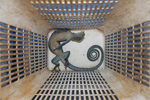
New species of woodlizard: Enyalioides binzayedi. Photo by: P.J. Venegas.
Scientists have discovered two new species of woodlizards from the Peruvian Amazon. Woodlizards, in the genus Enyalioides, are little-known reptiles with only 10 described species found in South and Central America. Described in a new paper in ZooKeys, both new woodlizards were found in Cordillera Azul National Park, the nation’s third-largest reserve.
“These species were discovered in recent expeditions to poorly explored areas on both sides of the Andes in Ecuador and Peru, suggesting that more species might be awaiting discovery in other unexplored areas close to the Andes,” the researchers write.
Scientists named one of the new species Enyalioides azulae, or the blue woodlizard, after the Cordillera Azul (Blue Mountains). The other was named Enyalioides binzayedi, or Bin Zayed’s woodlizard after Sheikh Mohamed bin Zayed Al Nahyan who helped fund the expedition through his Mohamed bin Zayed Species Conservation Fund (MBZSCF).
Although there are only ten known woodlizards worldwide, an astonishing nine of them can be found in Peru.
“Thanks to these discoveries, Peru becomes the country holding the greatest diversity of woodlizards. Cordillera Azul National Park is a genuine treasure for Peru and it must be treated as a precious future source of biodiversity exploration and preservation!” said lead author Pablo Venegas from the Centro de ornitología y Biodiversidad (CORBIDI) in Lima, Perú.
The Cordillera Azul National Park spans both lowland Amazonian rainforest and cloud forests on the eastern ridge of the Amazon. A survey in 2002 found 58 amphibians and 26 reptiles in a portion of the park.
There was no data yet on whether or not these woodlizards should be considered threatened. Currently no woodlizards have been evaluated by the IUCN Red List, which is the world authority on endangerment status for species.

Male and female (duller colored) of Enyalioides azulae. Photo by: P.J. Venegas.

Enyalioides binzayedi. Photo by: P.J. Venegas.

Enyalioides azulae. Photo by: P.J. Venegas.

New woodlizard habitat. The photo shows the montane rainforest on the top of the mountain ridge that forms the boundary between Region de San Martin and Region de Loreto. Photo by: A. Del Campo.
CITATION: Pablo J. Venegas, Omar Torres-Carvajal, Vilma Duran, Kevin de Queiroz. Two sympatric new species of woodlizards
(Hoplocercinae, Enyalioides) from Cordillera Azul National Park in northeastern Peru. ZooKeys 277: 69–90 (2013). doi: 10.3897/zookeys.277.3594
Related articles
Pictures: 20% of the world’s reptiles endangered
(02/15/2013) Nearly a fifth the planet’s reptiles are threatened with extinction, warns a new assessment published in the journal Biological Conservation.
Photo: Subterranean ‘Moby Dick’ mermaid lizard discovered in Madagascar
(01/16/2013) An international team of scientists have described a bizarre new species of worm-like lizard that lives underground. Strangely, they named it the ‘Moby Dick’ mermaid skink.
Photos: Neon blue dragon discovered in Vietnamese rainforest

(01/15/2013) German and Russian biologists have discovered a stunning new species of lizard in Vietnam. The species, dubbed Calotes bachae, is described in a recent issue of the journal Zootaxa. Calotes bachae is a type of agama, a group of lizards commonly known as ‘forest dragons.’
Photos: 3 colorful lizard species discovered in Australia
(12/19/2012) Researchers in Australia have described three new lizard species from the northwestern part of the continent.
Indonesia remains epicenter for illegal wildlife trade in reptiles and amphibians

(10/24/2012) Demand for exotic pets is driving the illegal harvest and trade of herpetofauna (reptiles and amphibians) in Indonesian New Guinea, according to a recent study published in the journal Biodiversity and Conservation. Between September 2010 and April 2011, Daniel Natusch and Jessica Lyons of the University of New South Wales surveyed traders of amphibians and reptiles in the Indonesian provinces of Maluku, West Papua and Papua.
Remarkable comeback: blue iguana downgraded to Endangered after determined conservation efforts
(10/23/2012) The wild blue iguana population has increased by at least 15 times in the last ten years, prompting the IUCN Red List to move the species from Critically Endangered to just Endangered. A targeted, ambitious conservation program, headed by the Blue Iguana Recovery Team, is behind this rare success for a species that in 2002 only numbered between 10 and 25 individuals.